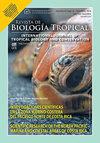哥斯达黎加阿提纳斯山区前潮湿森林片段中的中型和大型哺乳动物
IF 0.6
4区 生物学
Q4 BIOLOGY
引用次数: 0
摘要
引言:由于栖息地的丧失和破碎化,中大型哺乳动物在全球范围内受到威胁。在哥斯达黎加,保留在保护区外的森林碎片可以作为这些动物的避难所或走廊。哺乳动物在零散景观中的存在可能受到资源可用性的影响,而资源可用性在季节性地区差异很大。目的:确定森林碎片中中型和大型哺乳动物的物种丰富度,并检查物种多样性和可检测性在雨季和旱季之间是否存在差异。方法:我们在阿特纳斯市森林(哥斯达黎加阿拉胡埃拉)建立了26个相机捕捉站,这是一片26.4公顷的森林碎片,为约1800人提供水源。从2021年8月到2022年4月,在每个季节(旱季和雨季),每个站点都有一个相机陷阱,活动时间为12-21天,总共810个相机陷阱日。我们应用稀疏性和外推曲线来表征哺乳动物的物种多样性,并在不同季节进行比较。结果:共检出19种哺乳动物。最常被检测到的物种是白鼻Coati(Nasua narica;0.254次检测/摄像机捕获日)和中美洲Agouti(Dasyprocta punctata;0.163次检测/相机捕获日)。我们还登记了四种在哥斯达黎加被视为濒危物种的猫科动物:美洲狮、美洲豹、豹和新热带河水獭。季节性不影响物种多样性,但影响优势物种和可探测性,在雨季更大。结论:我们的研究证明了保护小森林碎片如何有助于在人类主导的景观中保护濒危的中大型哺乳动物。目的:我们旨在确定受水源生产保护的森林碎片中中型和大型哺乳动物的物种丰富度,并检查物种多样性和可检测性在雨季和旱季之间是否存在差异。方法:我们在阿特纳斯市森林(MFA)建立了26个相机捕捉站,这是一片26公顷的森林碎片,为大约1800人提供饮用水。从2021年8月到2022年4月,在每个季节(旱季和雨季),每个站点都有一个相机陷阱,活动时间为12-21天,总共810个相机陷阱日。我们应用稀疏性和外推曲线来表征哺乳动物的物种多样性,并在不同季节进行比较。结果:共检出19种中大型哺乳动物。检测频率最高的物种是白鼻Coati(Nasua narica;0.504次检测/摄像机捕获日)和中美洲Agouti(Dasyprocta punctata;0.377次检测/相机捕获日)。我们还在哥斯达黎加发现了四种被视为濒危物种的猫科动物:美洲狮、美洲豹、豹和新热带河水獭。季节性不影响物种多样性,但影响优势物种的可探测性。讨论:在MFA中观察到的哺乳动物相对较高的丰富度可能与周围的土地利用有关,该土地利用以农林系统(如咖啡种植园)和森林斑块为主,这可能有助于动物的流动,并在支离破碎的景观中作为避难所。结论:我们的研究表明,保护生态系统服务,如水,也可能有助于在支离破碎的景观中保护濒危的中大型哺乳动物。本文章由计算机程序翻译,如有差异,请以英文原文为准。
Medium and large-sized mammals in a premontane moist forest fragment, Atenas, Costa Rica
Introduction: Medium and large-sized mammals are threatened globally due to habitat loss and fragmentation. In Costa Rica, forest fragments that remain outside protected areas may serve as a refuge or corridor for these animals. Mammal presence in fragmented landscapes may be influenced by resource availability, which varies greatly in seasonal regions. Objective: To determine the species richness of medium and large-sized mammals in a forest fragment, and to examine if species diversity and detectability varied between the wet and dry season. Methods: We established 26 camera trap stations throughout the Municipal Forest of Atenas (Alajuela, Costa Rica), a 26.4 ha forest fragment that provides water to about 1 800 people. From August 2021 to April 2022, one camera trap was active at each station for 12-21 days throughout each season (dry and wet), for a total of 810 camera trap days. We applied rarefaction and extrapolation curves to characterize mammal’s species diversity and compare it between seasons. Results: We detected 19 species of mammals. The most frequently detected species were the White-nosed Coati (Nasua narica; 0.254 detections/camera trap day), and the Central American Agouti (Dasyprocta punctata; 0.163 detections/camera trap day). We also registered four species considered as endangered in Costa Rica, three felines: Puma concolor, Herpailurus yagouaroundi, Leopardus pardalis, and the Neotropical River Otter, Lontra longicaudis. Seasonality did not affect species diversity, but it influenced dominant species and detectability, which was greater during the wet season. Conclusions: Our study demonstrates how protecting small forest fragments, can help conserve endangered medium and large-sized mammals in human-dominated landscapes.
Objective: We aimed to determine the species richness of medium and large-sized mammals in a forest fragment protected for water production, and to examine if species diversity and detectability varied between the wet and dry season.
Methods: We established 26 camera trap stations throughout the Municipal Forest of Atenas (MFA), a 26-ha forest fragment that provides drinking water to about 1 800 people. From August 2021 to April 2022, one camera trap was active at each station for 12-21 days throughout each season (dry and wet), for a total of 810 camera trap days. We applied rarefaction and extrapolation curves to characterize mammal’s species diversity and compare it between seasons.
Results: We detected 19 species of medium and large-sized mammals. The species with the highest frequency of detections were the White-nosed Coati (Nasua narica; 0.504 detections/camera trap day), and the Central American Agouti (Dasyprocta punctata; 0.377 detections/camera trap day). We also detected four species considered as endangered in Costa Rica, three felines: Puma concolor, Herpailurus yagouaroundi, Leopardus pardalis, and the Neotropical River Otter, Lontra longicaudis. Seasonality did not affect species diversity but influenced the detectability of dominant species.
Discussion: The relatively high richness of mammals observed in the MFA is likely related to the surrounding land use, which is dominated by agroforestry systems (e. g., coffee plantations) and forest patches, that may contribute to animal mobility and serve as refuge in fragmented landscapes.
Conclusions: Our study demonstrates how protecting ecosystem services, such as water, may also help conserving endangered medium and large-sized mammals in fragmented landscapes.
求助全文
通过发布文献求助,成功后即可免费获取论文全文。
去求助
来源期刊

Revista De Biologia Tropical
生物-生物学
CiteScore
1.80
自引率
0.00%
发文量
23
审稿时长
4-8 weeks
期刊介绍:
The Revista de Biología Tropical / International Journal of Tropical Biology and Conservation is a mainstream scientific journal published since 1953 and covered by Web of Science; Science Citation Index; Current Contents; Google Scholar; Scopus, SciELO and nearly 50 additional indices.
A double blind system guarantees you a fair evaluation, and our world class editorial and scientific boards provides a first decision in three working days. The journal is Full Open Access and is widely read where your article can have the highest real impact.
Since its beginning in 1953, the Revista follows these principles: objective and independent evaluation of all manuscripts; transparency in all processes; ethical use of procedures, data, specimens and subjects; fair treatment of all parties; and absolute predominance of scientific rigor over any other aspect.
 求助内容:
求助内容: 应助结果提醒方式:
应助结果提醒方式:


